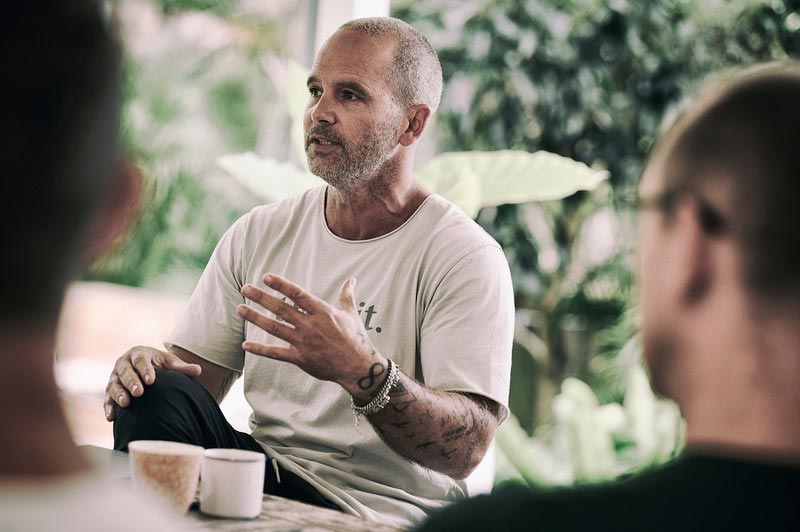
As I write this I make sure that I always talk and write from direct experience and how I came to these principles for myself, even though of course, they are not my own.
On reflection, I probably came to the concept of recurring priorities through David Alan and his seminal work on the topic of time management called Getting Things Done.
He spoke about the concept of recurring entries as a way to gain control of your calendar, schedule and life because you start to know what each day and week is going to look like as a function of the occurrence.
For example, every Monday at 7:00 am I do a fitness training session and I do it with … (in my case, Sven).
He also introduces the idea of batching: putting stuff/things into the same or similar categories – again, an example, I do all my bill payments, banking and invoicing on Thursdays at 2:00 pm and on it goes.
In the work I do at the Shift I distinguish between recurring priorities and pillar practices.
A pillar practice is always recurring and it generally happens on a daily, weekly or fortnightly basis. If it happens less frequently then it is either a ritual, tradition or recurring priority.
For an activity to be recurring it must be a priority, otherwise, why do it?
Recurring priorities will have layered levels of importance, usually have flex in whether they are actioned and do not fill one’s cup in the same way as a pillar practice.
Dropping my daughter at daycare on a specific day is for me an example of a recurring priority. It is important for me, my wife, our kids and us as a family unit that I can be relied on to get my daughter to daycare. However, that particular task is not one where I am devoting particular time and energy to her. I have other actions and activities that fulfil that with her. As such, if my wife is available to do the drop off I will ask her to do it.
Again, I am clear on my commitment to my family and as a father. I am clear how important it is that my daughter gets to daycare and that her getting there on time is important but it is not a pillar it is a recurring priority.

I am often asked this same question around ‘work’, especially by men, they say one of two things (or both). The first is that work is a pillar due to the importance of money needed to sustain the family, and the second is that they enjoy work and therefore it is a pillar.
I would assert that all elements of work are recurring priorities and they are definitely that for me.
I absolutely love my work, it sustains and nurtures me on many many levels. I feel that when I am teaching I gain clarity, commitment and an incredible sense of fulfilment. Teaching is very important to me and I will be mindful that as the Sit and Shift grow that I do not find myself in a situation where I step away from the course element and into day to day commercial activities.
However, even in that, it is not a pillar – it is a recurring priority.
Other recurring priorities on the work front are internal team meetings, strategy and planning, business development, admin, system process etc.
My method is to create recurring work blocks and then theme them. For example, Tuesday mornings are HQ and leader focused and that is the time that Jason and I have our co-founder meeting.
A diary/schedule/rhythm comes together when pillar practices and recurring priorities are created and entered – see a diagram of the diary and my recurring priorities and the list from my purpose document.
Recurring priorities must (I don’t use that word often) be fluid and contextual whereas pillars will rarely change.
For example, my commitment to a twice-daily meditation practice of 20 minutes within specific time parameters is unlikely to change much at all, but what I do at work and what I prioritise will change. For example, at the moment we are preparing ourselves for approaches to investors in a couple of businesses that I am involved in, one of which is the Sit. That will influence what I do and when I do it, and therefore how I spend my time.

Getting clear around recurring priorities is more nuanced than pillars but it starts similarly – with an examination of the sub facets as follows:
- What activities in this sub facet are important right now and what could become important?
In a work context I suggest some of the following:
Brainstorm:
- What are you enjoy doing?
- What do you need to do?
- What are you not enjoying?
Then consider discussions with:
- Direct reports – people who manage you or you manage
- Associates and friends
- Team
- Clients and suppliers
- A coach or mentors
How this all looks will obviously depend on the type of work that you do and your role.
Four resources that really helped me were:
- 7 habits of highly effective people
- The E Myth
- Traction
- Getting things done
Those books really helped me to get clear on the importance of a system process, in a life and business context.
Jason and I also have regular business coaching with a coach who aligns with these processes.
So in summary, brainstorm, brainstorm, brainstorm and use the facet model as the prompter for the simple questions:
What am I doing?
What could I be doing?
What do I need to stop doing?
Ask yourself that question in every sub facet. Then schedule and create the rhythm.
Treat it as a canvas and an opportunity, and one that YOU are creating. It is not being done to you. You are creating, and therefore being at cause in designing your life. You are creating a life that works, underpinned by wholesome prioritisation.
And ask yourself with all the activities: are they pillars or are they priorities?
Remember that a recurring priority may become a pillar and a pillar may become a recurring priority.
You also may drop them after they’ve reached their use-by date.
Just do it consciously and consider doing it in collaboration with like-minded individuals.
Go well as you create a life that works, one that is consistent with who you are committed to being in the world and what you are committed to doing.
That is key to having a life that works, one that matters and one that expresses our own personal wondrous vision.
I am simply a man, living a life, serving, being served, creating impact, practising my commitments and understanding it is all an ebb and flow.
Sometimes I have it and sometimes I do not, and ultimately it is the practice of capacity, acceptance and presence that underpins everything.
Ho and love,
Sherpa



